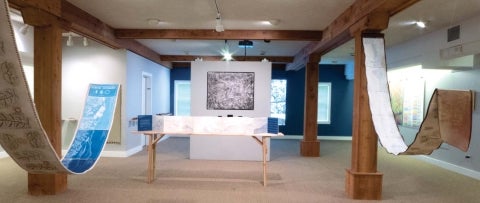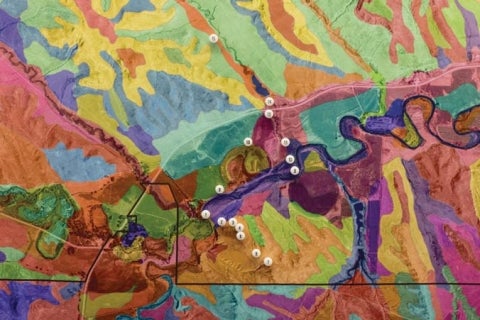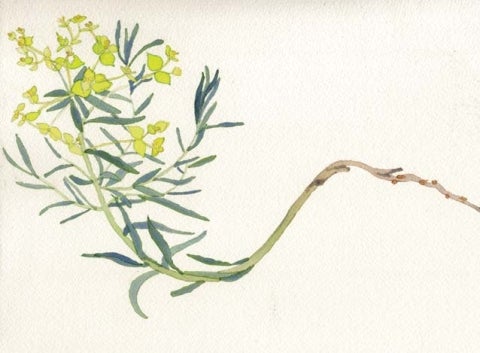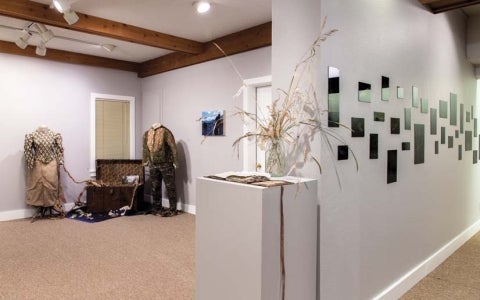Note: Yale School of the Environment (YSE) was formerly known as the Yale School of Forestry & Environmental Studies (F&ES). News articles and events posted prior to July 1, 2020 refer to the School's name at that time.
 <p class="p1"> Exhibition view, 2015, Ucross Foundation Art Gallery</p>
<p class="p1"> Exhibition view, 2015, Ucross Foundation Art Gallery</p>
During the summer of 2013, a group of artists and Yale ecologists met at the Ucross Foundation, a 22,000-acre working cattle and sheep ranch in the High Plains of northeastern Wyoming. The encounter resulted in interdisciplinary collaborations that explore the environmental and social landscape of the Ucross Ranch.
An art exhibit showcasing these collaborations — “Ucross: A Portrait in Place” — opens at 3 p.m. Friday in Kroon Hall’s GO1, followed by a panel discussion on interdisciplinary storytelling at 4 p.m. in Burke Auditorium.
The exhibit reveals the beauty and complexity of what it means to truly inhabit a place. It features works by six artists from the University of New Mexico’s Land Arts of the American West program and Charlie Bettigole, an ecologist and Program Director of the Ucross High Plains Stewardship Initiative, an F&ES-based research program exploring issues of land stewardship in the American West.
An art exhibit showcasing these collaborations — “Ucross: A Portrait in Place” — opens at 3 p.m. Friday in Kroon Hall’s GO1, followed by a panel discussion on interdisciplinary storytelling at 4 p.m. in Burke Auditorium.
The exhibit reveals the beauty and complexity of what it means to truly inhabit a place. It features works by six artists from the University of New Mexico’s Land Arts of the American West program and Charlie Bettigole, an ecologist and Program Director of the Ucross High Plains Stewardship Initiative, an F&ES-based research program exploring issues of land stewardship in the American West.
The works defy simple categorization. For example, in Without soil there is no color, artist Janette Hart-Mann and Bettigole use recorded birdsong and soil collected at the Ranch to create a mixed media piece expressive of both scientific and aesthetic curiosity.
 <p class="p1"> Jeanette Hart-Mann with Charlie Bettigole, Without soil there is no color (detail fine art print), 2015, 3 - 43x47.5”, archival fine art print.</p>
<p class="p1"> Jeanette Hart-Mann with Charlie Bettigole, Without soil there is no color (detail fine art print), 2015, 3 - 43x47.5”, archival fine art print.</p>
Others — such as Cynthia Brinich-Langlois’s accordion art-book Death of A Leafy Spurge and Bill Gilbert’s walking-based, map projects — play with space and time. Theses pieces are at once precise and imaginative, inviting the viewer to reflect on the interconnected meanings of place.
Both a retreat center for artists in residence and also space for ecological research and conservation, Ucross has long been a home for artistic and scientific experimentation. The Ranch, founded by businessman Raymond Plank ’44, has hosted nearly 1300 visual artists, writers, and composers since 1981. It is also the site of extensive scientific research by wildlife biologists, soil scientists, hydrologists, and cartographers — including a growing number of researchers from F&ES — working to make Ucross a model of land stewardship for the 21st century.
 <p class="p1"> Death of a Leafy Spurge (1 of 7), 2014, each 11x14”, watercolor and graphite drawings.</p>
<p class="p1"> Death of a Leafy Spurge (1 of 7), 2014, each 11x14”, watercolor and graphite drawings.</p>
“We saw early on that there seemed to be really close parallels in the way artists work and the way that scientists work,” said Sharon Dynak, President of the Ucross Foundation. “They both involve risk-taking and experimentation, following intuition but also bringing knowledge and experience to what they do.”
Bettigole hopes the Kroon exhibit will capture the essence of its original incarnation at the Ucross Foundation’s art gallery.
Bettigole hopes the Kroon exhibit will capture the essence of its original incarnation at the Ucross Foundation’s art gallery.
“To reach the Ucross ranch you drive through the High Plains; there are rolling hills, pasture, sagebrush, and almost nothing else,” Bettigole says. “Then you arrive at Ucross and there’s this beautiful gallery inside a red barn. And there’s a portrait of place that’s just incredible. The pieces just have a real sense of movement. And this exhibit captures that sense of place and movement, too.”
 <p class="p1"> Exhibition view, 2015, Ucross Foundation Art Gallery</p>
<p class="p1"> Exhibition view, 2015, Ucross Foundation Art Gallery</p>
Published
January 20, 2016